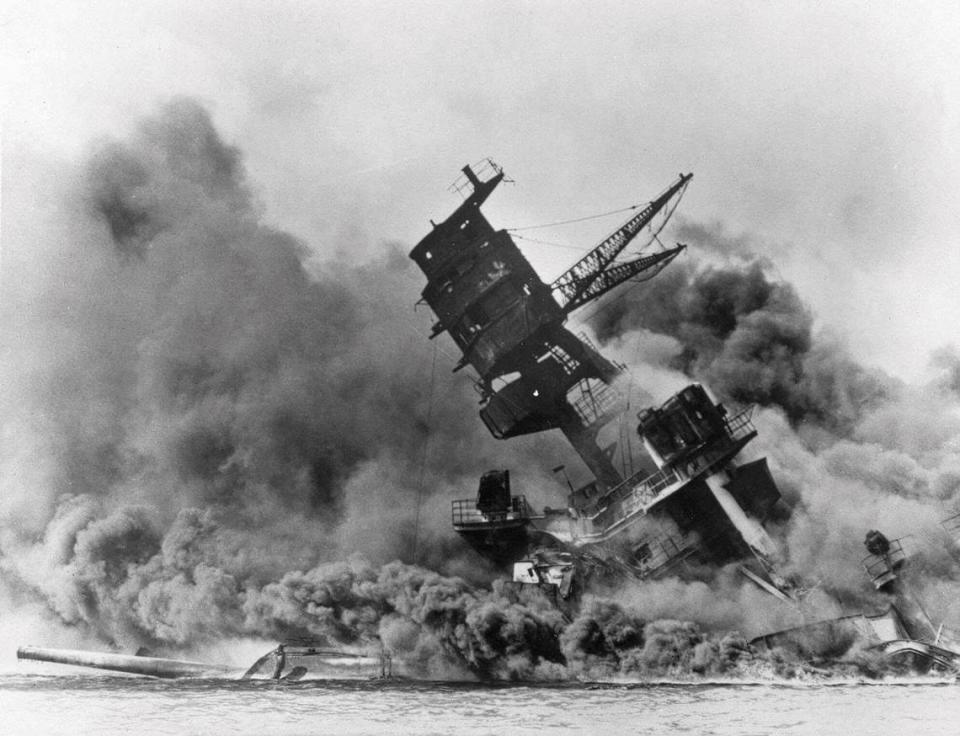For one Ky family, Dec. 7 was a day that lived in infamy and confusion
Nearly every American reacted with shock and anger after hearing about the surprise Japanese air raid on Pearl Harbor, Hawaii, 81 years ago on Dec. 7.
Fear, too, gripped L.A. and Gertrude Tapp, who operated Shakertown Fruit Farm on the Harrodsburg-Shakertown Road in Mercer County. Their son, Lambert Ray Tapp, was a gunner’s mate third class aboard the battleship Arizona, which blew up and sank that sunwashed Sunday morning.

Most Americans learned of the attack from radio news flashes. The first reports reached central Kentucky in the early afternoon.
For two weeks, the Tapps didn’t know what happened to their son. A Dec. 21 telegram brought the dreaded news: He was “missing following action in the performance of his duty and in the service of his country.”
“’Missing’ means ‘probably dead,’” said Daniel Martinez, chief historian at the Pearl Harbor National Memorial. But many mothers, fathers and wives chose to interpret the word as “they haven’t found him yet— they’re somewhere; maybe they were captured by the Japanese,” he added. Any such hopes vanished with news that the enemy didn’t invade Hawaii.
Two more telegrams followed. One on Jan. 6 said the sailor was alive. Three days later, came the third wire: it said the second one was wrong; Lambert Ray really was missing.
Early news reports provided few details of the attack that plunged the U.S. into World War II. While it focused on the naval base on Oahu, enemy planes also bombed and strafed the island’s military airfields.
Shortly after the raid began, a bomb crashed through the Arizona’s forward deck, detonated and ignited powder magazines for the ship’s guns and aviation gas for its scout planes. The explosion triggered “a chain reaction that turned the ship itself into a bomb,” wrote historian Craig Nelson in “Pearl Harbor: From Infamy to Greatness,” his 2016 book.
The blast produced an enormous fireball and heaved the 32,600 ton battlewagon out of the water. The stricken ship virtually broke in half.
Crashing back to the harbor, the Arizona, engulfed in flames, sank in just 9 minutes. “The souls of 1,177 sailors and marines were lost, more than died in the Spanish-American War and the First World War combined,” according to Nelson.
All told, 2,335 U.S. sailors, soldiers, airmen and marines — plus 68 civilians — died during what FDR condemned as a “dastardly and unprovoked attack.”
The bleakest of Christmas holidays suddenly turned to joy when the second wire arrived. Lambert Ray was among the living and would “doubtless communicate with you at an early date informing you of his welfare and whereabouts.” The Navy “deeply regretted” any “anxiety caused by the previous message.”
The telegram furnished L.A. and Gertrude “a very happy new year,” according to the Harrodsburg Herald. They were looking forward to hearing from Lambert Ray.
When the third wire arrived, the Tapps may have guessed it was from Lambert Ray. Their hearts sank when they read it.
It was from the Navy. A Murray Leland Tapp had survived, not their son. Lambert Ray was “now reported missing upon the latest casualty lists.” The Navy “fully appreciated” the family’s “great anxiety” and promised “any report as to the fate of your son will be communicated to you promptly when received.”
Tapp’s remains were never recovered; he and more than 900 of his shipmates were left entombed on the Arizona. Their names are enshrined on the USS Arizona Memorial, a gleaming white structure that straddles, but does not touch, the shattered, rusting hulk of the battleship, which still leaks small droplets of fuel oil called “the tears of the Arizona.”

Berry Craig is an author and historian who wrote “Kentuckians and Pearl Harbor: Stories from the Day of Infamy,” which the University Press of Kentucky published in 2020.

 Yahoo Movies
Yahoo Movies 
